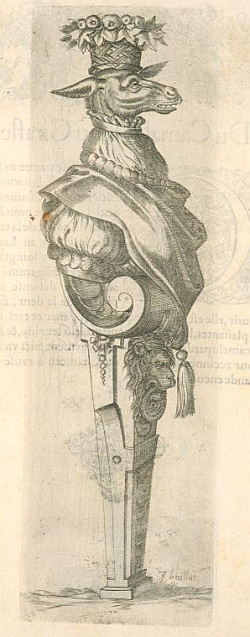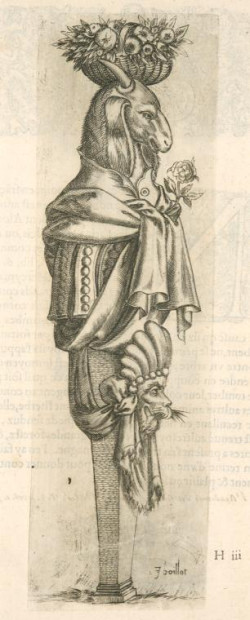[click on the images for larger versions]
Artist and engineer Joseph Boillot (1546-c.1603) was part of the military adminstration in France at Langres under Henri IV. First published in 1592, Pourtraitz et Figures de Termes Pour User en Architecture draws influence from such classics as Pliny's Natural History in displaying animals pairs with natural antipathy adjacent to one another on the book's open pages. There are said to be allegorical as well as architectural motifs represented.
He engraved these baroque ornamental plinths from wood or copper and there are 55 illustrations accompanying his text. All engravings from this very rare and amazing book are online at NYPL (thumbnail page). I get the feeling that not all of the images are from the same edition - and indeed, I have 'sharpened' a couple of the images above (that's the only adjustment I ever make to images and I've done it to maybe 3 other -- usually faded engravings -- illustrations previously) to make them a touch clearer. A later German edition is said to be far superior.
The fantasy column illustrations were meant: "to provide models for artists, sculptors, carpenters, glass painters, goldsmiths, cabinet-makers, craftsmen, and "lovers of art". This strange and lovely book can also be viewed as a bestiary of sorts. The illustrations provide fascinating archetypes from the world of real and imaginary beasts via images of bears, red deer, lions, leopards, wild boars, wolves, camels, unicorns, horses, bulls, elephants, rhinos, rams, dall sheep, hunting dogs, porcupines, monkeys, donkeys, goats, tigers, antelopes, etc., which are incorporated into busts, statues and plinths."
- UPDATE Dec. 2013: this Architectura article from 2004 by Yves Pauwels provides good (bilingual) commentary on our Boillot's opus of structural zoomorphia.
- This Sims Reed site shows how the illustrations appeared on the book pages.
- August Laube have a decent review of the work - the most authoritative I could find.
- This is a translated cached page, ostensibly dealing with Bulliot's other major publication on weaponry. I am very surprised that there is so little online about Bulliot and his Pourtraitz.




























6 comments :
What a great find—I’d never heard of Boillot before. These designs seem like distant cousins (or uncles, maybe, seeing as how they’re probably earlier) of Christoph Jamnitzer’s grotesque designs…
Oh yes, I remember - that was a good post misteraitch.
I'd like to find out more about the text that accompanied Boillot's figures. There's scant little commentary on the 'net however. Pity.
Fantastic!
Great!
I got one more taken from "Nouveaux Recueil de Termes".
Boillot is well known here as Boillot de Langres.
I am located near Montigny sur Aube castle (designed by Jean Bullant" and Polisy castle (decorated by Primatice).
In Langres Town you can see in St Mames cathedral Tapistery designed by Jean Cousin et chapelle designed by jean Bullant.
{see also comments in this post}
============
Below: Just posting this in from the August Laube site (in case it becomes a dead link, as the others 'seem' to be - maybe needs archive.org)
==================
[quote]
"One of the most astonishing documents about provincial mannerism of this period is Joseph Boillot's 'New Termis Buch'. It consists of a series of fantastic designs for therms, in which the entablatures are supported by animals, grouped in pairs according to the 'antipathy' between them as indicated by the Natural History of Pliny and other ancient authors." (Blunt, Art and Architecture in France 1500-1570, p. 146).
New Termis Buch, Von allerley grossen vierfüssigen Thieren zugerichtet... Mit beygefügter Thieren Contrarieteten, sampt etlicher massen Beschreibungen,... (Strassburg ?) 1604. Small-Fol. With an engraved title-page border around the red and black printed title, 39 engraved plates and 16 woodcuts. 32 unnumbered leaves [ ):(4, A-D6, E4]. Contemporary, German half vellum over green boards, fabric ties.
First German edition of this very rare and extremely interesting Baroque ornament and model book. BL, German, 1785. Graesse I, 473. Berlin Katalog 3923 (now destroyed, lacked two leaves). J. Betz, Bibl. Bibliogr. Aureliana no. 92 (notes only one copy, in the British Library). Cf. Harvard French Cat. 108. Brunet I 1064 and Suppl. I, 147. Robert-Dumnesil VI, pp. 72-87 (first French edition, Langres 1592). The illustrations of fantasy columns, executed in either woodcut or copper-engraving, creatively use animals and beasts, which are factual, mythological, and/or allegorical, to provide models for artists, sculptors, carpenters, glass painters, goldsmiths, cabinet-makers, craftsmen, and "lovers of art". This strange and lovely book can also be viewed as a bestiary of sorts. The illustrations provide fascinating archetypes from the world of real and imaginary beasts via images of bears, red deer, lions, leopards, wild boars, wolves, camels, unicorns, horses, bulls, elephants, rhinos, rams, dall sheep, hunting dogs, porcupines, monkeys, donkeys, goats, tigers, antelopes, etc., which are incorporated into busts, statues and plinths. The present edition must be seen to be fully appreciated: it is superior to the author's "Nouveux Pourtraitz et figures de termes pour user en l'architecture" (Langres, 1592) in that here the dramatic mis-en-page emphasizes the verticality of the columns, with each page featuring an engraved Baroque column beside one column of Fraktur text, as does the opposing page; therefore two engraved columns and two text columns appear on one page-opening. The work consists of 39 signed etchings and 16 woodcuts by Boillot.
Joseph Boillot was an engineer and an artist. He engraved on both wood and copper for illustrations for his own books, including the present work and the famous "Instruments de Guerre", published at Chaumont-en-Bassigny in 1598. Boillot served as "controleur pour le Roi" for Henri IV's military administration at Langres, France.
In very fine, original condition; the early inscription (dated March 1st, 1675, recording the purchase by Abraham Durtz [or Duntz ?] from Iscambri Bredigkant) on first blank, which is conjugate with the front pastedown, proves the binding's early date.
Extremely rare: Besides a handful of copies in institutions there have been only two on market in recent years.
[unquote]
great find! its almost an analogue manifestion of William Burroughs writing techniques of the cut up, and the fold in.
Rearranging the present, into an arbitrary order, you may find that
“Perhaps when you cut into the present the future leaks out“
William Burroughs, Origin and Theory of the Tape Cut-Ups, break through in grey room. From a lecture given by Burroughs at the Jack Kerouac School of Disembodied Poetics at Naropa Institute, April 20, 1976
This stuff is really interesting.
if anybody finds anything on architectural zoology, parallel botany or fabled sea monsters or giant squid please post on my blog. will be much appreciated.
pantherflash.blogspot.com
Post a Comment
Comments are all moderated so don't waste your time spamming: they will never show up.
If you include ANY links that aren't pertinent to the blog post or discussion they will be deleted and a rash will break out in your underwear.
Also: please play the ball and not the person.
Note: only a member of this blog may post a comment.